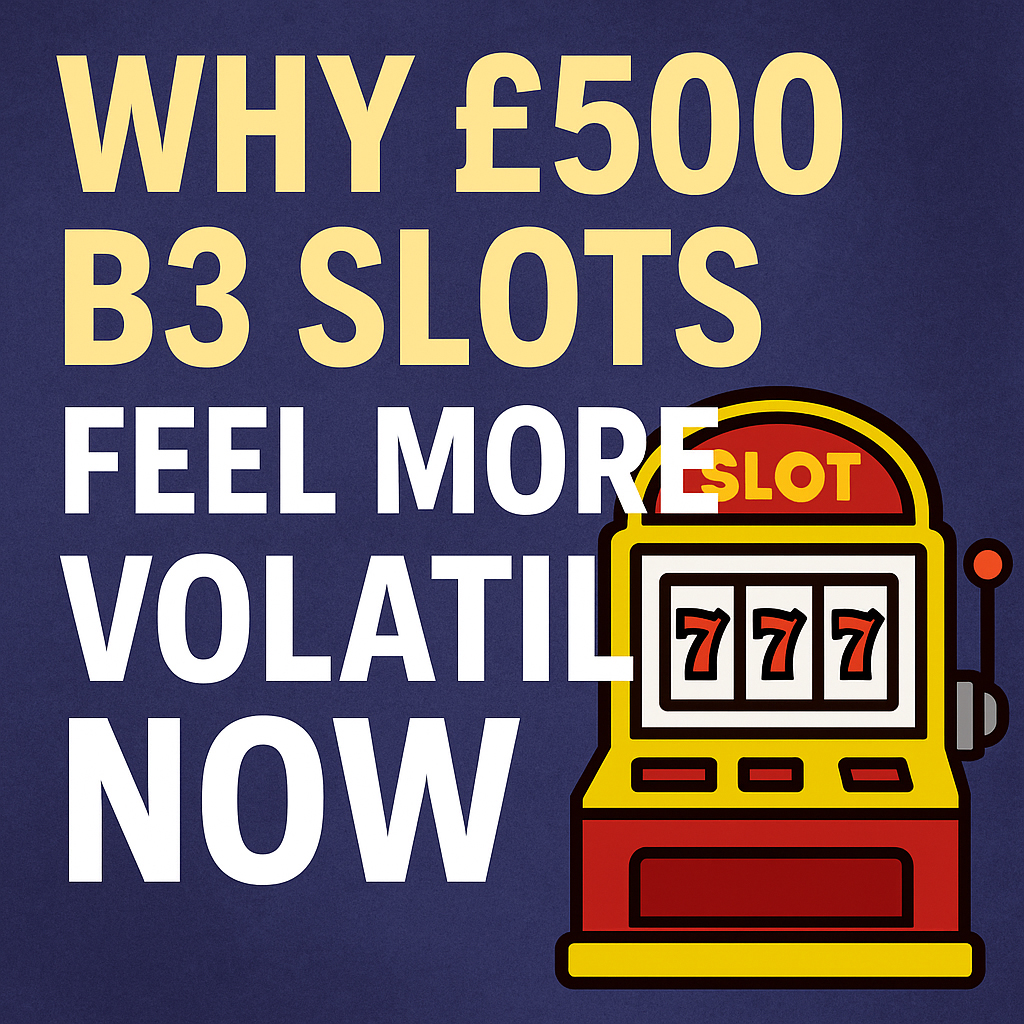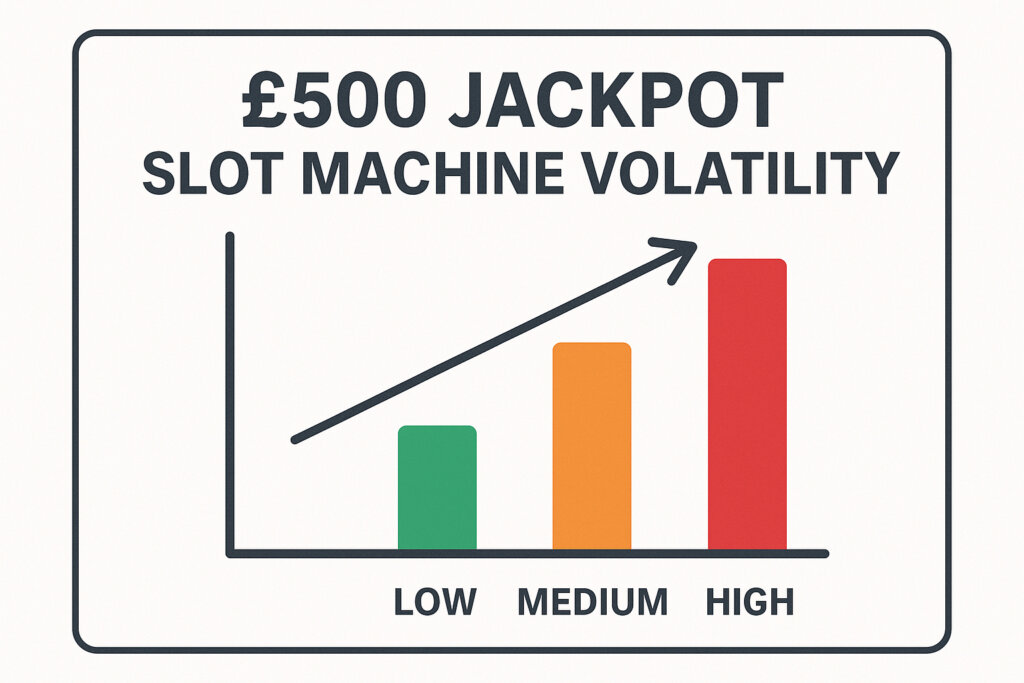
Why are £500 Jackpot Slots so Volatile?
- Modern B3 slots are built for higher variance – bigger top-end hits but longer gaps between wins.
- No fixed minimum RTP means manufacturers can tune returns more flexibly (and more aggressively).
- Post-B2 market changes pushed designers to make £2-stake games feel exciting, leading to today’s spikier maths models.
Walk into an AGC (Adult Gaming Centre) or bingo hall today and the B3s often feel like a roller-coaster: long dry spells, then a burst of action when a bonus finally lands. That experience isn’t your imagination—it’s largely a product of how the maths of modern games has evolved, the market changes since the B2 (£100 stake) era ended, and how regulation frames (and sometimes doesn’t frame) game design.
The short version
-
Designers actively set volatility. Today’s B3s are deliberately built with higher variance to create bigger “top-end” moments inside a strict £2/£500 framework.
-
No minimum RTP, more flexibility. For B3s, the manufacturer sets the RTP and must display it, but there’s no statutory minimum RTP in the category—so some games ship with lower target returns, which makes losses bunch up more and wins feel rarer/bigger.
-
Post-B2 shift changed the market. When B2 stakes were cut to £2 (2019), a lot of player demand moved to B3 products; to keep games exciting at £2, designers leaned into higher-variance models and “feature-heavy” maths.
-
Category rules set the stage. B3 specs cap stake at £2, prize at £500 and set a 2.5-second minimum spin—so the “wow factor” has to come from variance, not faster spins or bigger stakes.
What changed under the hood?
Volatility is now a design dial. Game studios don’t just pick an RTP and walk away; they also pick how spiky the journey to that RTP feels (how often small wins land vs. how rarely bigger hits do). The Gambling Commission’s guidance makes it explicit: designers calculate theoretical RTP and volatility and these are part of testing and ongoing monitoring. That means today’s trend towards punchier, bonus-driven maths is a conscious choice.
RTP flexibility = wider outcome swings. Unlike several other gambling products, B3 machines don’t have a mandated minimum RTP. The manufacturer chooses the theoretical target and must display it, but the law doesn’t set a floor. Lower RTPs (even by a few points) increase the house edge, and when combined with “save-up-for-the-bonus” maths, you get longer downswings between meaningful hits—what players read as “more volatile.”
The B2→B3 migration effect. After the £2 stake limit arrived for B2s, B3s took centre stage on the high street. Operators and studios had to recreate excitement within the same £2 stake ceiling, so games leaned into high-variance bonus structures (bigger potential during features, fewer medium hits in the base). Industry data and reporting show B3 floors and revenues grew in the years after the stake change, reflecting that market pivot.
Fixed category constraints push variance. B3s are tightly defined: £2 max stake, £500 max prize, minimum 2.5 second spins. You can’t dial up speed or raise stakes to create drama—so studios create drama by sparsifying wins and loading more value into rarer features. That pushes the hit-rate down and the pay-spreads up.
More B3 supply = more “modern” maths. Policy choices like the long-standing “80/20 rule” (capping the proportion of B machines) have been debated and tweaked over the years, but the broad trend is more B3 availability on the high street. More new cabinets means more contemporary maths—i.e., the current high-variance fashion—replacing older, flatter games many players cut their teeth on.

How that plays out for real players
-
Longer deserts, bigger oases. You’ll often see stretches of low returns punctuated by a feature that finally pays a decent win—classic high-variance behaviour. (The Commission also notes that RTP is an average over vast cycles, so session-to-session swings are normal.)
-
Bonus-centric pacing. Many modern B3s funnel value into free spins, upgrades, or collector mechanics. That can feel thrilling when it hits, but it also means more spins where “not much happens” in the base game while you chase that moment.
A quick reality check on the rules
-
What B3s are, formally. B3 games: £2 max stake, £500 max prize, ≥2.5s per game. You’ll find them in AGCs (including motorway services), bingo clubs, and betting shops.
-
RTP disclosure, not a floor. The theoretical target must be shown to players, but there’s no statutory minimum for the category—so always read the help screen.
Practical tips if you’re playing B3s
-
Pick your volatility on purpose. If a machine’s help screen lists a lower RTP and showcases huge “win potential,” assume rockier sessions. If you prefer steadier play, look for titles with more frequent base-game hits or simpler features.
-
Session bankroll rules. Decide your stake, session budget, and a walk-away plan before you start. High-variance games can burn a stake quickly while you wait for the feature.
-
Aim for entertainment, not expectation. With £500 max top and modern high-variance maths, the fun is in the ride, not in reliably topping up a bankroll.
-
Use the info provided. Check each machine’s help pages for RTP and feature structure; treat “RTP over long term” literally—short-term swings dominate sessions.